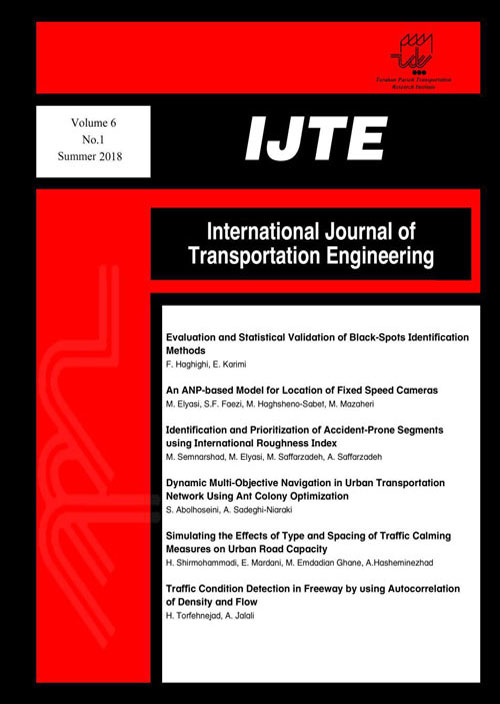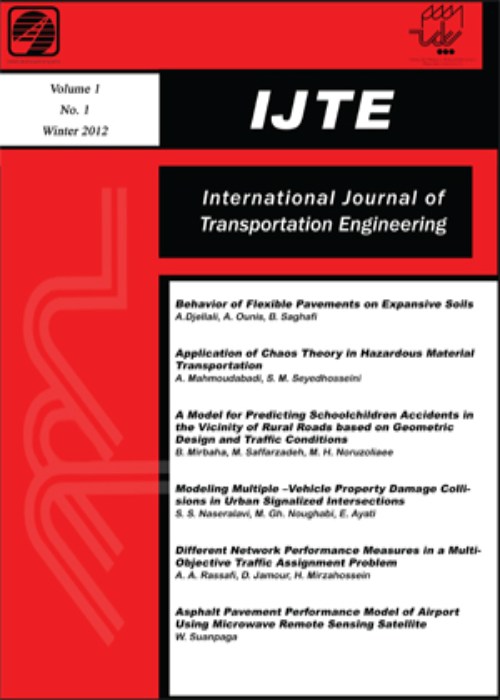فهرست مطالب

International Journal of Transportation Engineering
Volume:8 Issue: 3, Winter 2021
- تاریخ انتشار: 1399/12/27
- تعداد عناوین: 6
-
-
Pages 211-223
International studies on bicycle demand have shown that females and males can have different transportation behavior due to their innate differences, as in social responsibility and access to facilities. Considering the almost equal and significant share of females in urban trips, and also the cultural aspects, this issue is of even more importance in Tehran, which lacks detailed focused research studies. This paper aims to model bicycle demand for Tehran stressing on gender difference impacts. Regarding the scope of the research, a questionnaire field survey was designed to gather the required data for modeling purposes. Using a random sample of Tehran citizens stratified by employment status, the field survey was conducted, in March 2013. Data collected include demographic, economic, environmental, and travel information. The survey included the question, “How much do you use bicycle for urban trips?” as the dependent variable. Choice answers include four alternatives: never, rarely, sometimes, and often. Based on the collected data, ordered logit models are calibrated separately for males and females to analyse gender impacts on bicycle demand. Results indicate that age, number of cars, number of bikes and access to public transportation have different impacts on the demand of females and males for bicycle trips. Also, some variables such as education level and access to bike houses are found to be significantly related to males cycling but not females. It was also concluded that better and more in-depth information about gender differences in using bicycle is gained by estimating separate models for females and males.
Keywords: cycling, gender impacts, non-motorized transportation, Ordered logit -
Pages 225-246
Reducing fuel consumption by transportation fleet in a supply chain, reduces transportation costs and consequently, the product final cost. Moreover, it reduces environmental pollution, and in some cases, it helps governments constitute less subsidies for fuels. In this paper, a supply chain scheduling is studied, with the two objective functions of minimizing the total fuel consumption, and the total order delivery time. After presenting the mathematical model of the problem, a genetic algorithm, named Social Genetic Algorithm (SGA) is proposed to solve it. The proposed algorithm helps decision makers determine the allocation of orders to the suppliers and vehicles and production and transportation scheduling to minimize total order delivery time and fuel consumption. In order for SGA performance evaluation, its results are compared with another genetic algorithm in the literature and optimal solution. Finally, a sensitivity analysis is performed on SGA. The results of comparisons also show the high performance of SGA. Moreover, by increasing the number of suppliers and vehicles and decreasing the number of orders, the value of the objective function is reduced.
Keywords: Transportation, Fuel consumption, Supply chain management, routing, Genetic Algorithm -
Pages 247-260
Pavement performance prediction is a mounting task due to the many varied influencing factors particularly aging which varies with time, weather, production, type of pavement and etc. This paper presents a conventional mathematical model named Superpave model, Artificial Neural Network (ANN), and Supporting Vector Machine (SVM) techniques to predict the effects of extended aging on asphalt mixture performance measured in terms of rutting properties determined from the dynamic creep test. The accuracy of each method was compared to select the most reliable technique that can be used to forecast the rutting behavior of asphalt mixtures subjected to different aging conditions. The results indicated that the Superpave model was only reliable at lower temperatures, while ANN and SVM techniques showed the capability of precise prediction under all conditions. The overall results showed that the ANN was the most promising technique that can be adopted to satisfactorily forecast the effects of aging on rutting properties of all mixtures. The developed model can be embraced by the pavement management sector for more precise estimation of the pavement life cycle subjected to different aging conditions which can be used to design efficient pavement maintenance and rehabilitation plans.
Keywords: Asphalt mixture aging, Rutting, Superpave model, Artificial Neural Network, supporting vector machine -
Pages 261-278
In the past few decades, many research pieces were devoted to Automated Guided Vehicles (AGVs), both in hardware and software technology. Nowadays, these are popular for the automatic handling of materials, goods, and containers. They provide more efficient and flexible solutions for manufacturing and transportation systems. This paper does a survey on Automated Guided Vehicles in the real world, in port automation for automatic container handling and manufacturing systems for flexible material handling systems. The results of this survey reveal several corollaries over usage, modeling of problems, and solutions. Moreover, it presents several challenges for future research. The first challenge is to perform a simulation model that can handle multiple layouts in both container terminals and manufacturing systems. The second challenge is to work on the new technology of AGVs, which involves Industry 4.0. The third challenge is concerned with some dynamic vehicle routing strategies based on a two-tiered simulation. The fourth challenge is to develop more efficient algorithms for various problems of routing AGVs in practical applications.
Keywords: Automated Guided Vehicles, Transportation, Flexible manufacturing systems, Port Automation -
Pages 279-298The study worked on direction-wise dynamic Passenger Car Equivalent (PCE) model to optimize delay at signalized intersection under heterogeneous traffic condition. Static PCE values are usually practiced to transform heterogeneous traffic into homogeneous stream. However, the PCE values are dynamic due to variation in vehicle composition. Video sensors were used to count direction-wise classified vehicle at various signalized intersections for this research. The adaptive PCE values were compared with the PCE values used in the manual of Roads and Highway Department (RHD), Bangladesh. Furthermore, Synchronous regression method was performed to estimate saturation flow. Field total delay was estimated from queuing diagram considering residual queue, arrival and saturation flow rate. After that, signal timing was adjusted by optimization of total delay. RHD manual based PCE was observed to be underestimated comparing to direction-wise dynamic PCE in case of field delay and optimized delay by 6.79% and 27% respectively. Turning vehicles occupy more space and time and influence operation of signalized intersection. Hence, conventional PCE estimation failed to comply with actual scenario, and consequently, could optimize signal timing inaccurately. This study can be used as a framework to calibrate practiced PCE values in the road capacity manual and design traffic signal.Keywords: Direction-wise dynamic PCE, Right-turning vehicle, Heterogeneous traffic, isolated signal optimization, delay
-
Pages 299-316Aggressive driving is a global road safety concern. However, little research has been conducted to understand the frequency of aggression nor what factors contribute to this. Moreover, in these researches, the effect of personality aspects on various driving anger expressions has not been investigated. The current study aims to investigate how drivers express their anger aggressively and its relationship with The Big Five personality traits. A total of 534 licensed drivers; 36.1 % had been involved in at least one crash in the last three years completed a brief survey assessing aggression and personality. Specifically, the driving anger expression inventory, which measures the frequency of verbal aggression, personal physical aggression, aggressive use of the vehicle and adaptive constructive responses, was investigated. The most common type of aggression was verbal aggression. Younger, and male drivers reported more frequent aggression. Neuroticism was related to all types of aggression, showing individuals with more neurotic characteristics also have more frequent verbal, personal physical aggression, use the vehicle more often to express anger and have less frequent adaptive constructive ways of dealing with anger. Neuroticism was also related to more crash involvement. In contrast, drivers with higher levels of conscientiousness more frequently dealt with anger in a constructive way and had been involved in fewer crashes. These findings show that the behavior and performance of drivers can be related to their personality and individuals higher in neuroticism report more dangerous behavior. This is important to assist with strategies to reduce high-risk driving in individuals.Keywords: Driving Anger Expression, Safety strategies, aggressive driving, Accidents, the big five personality traits


